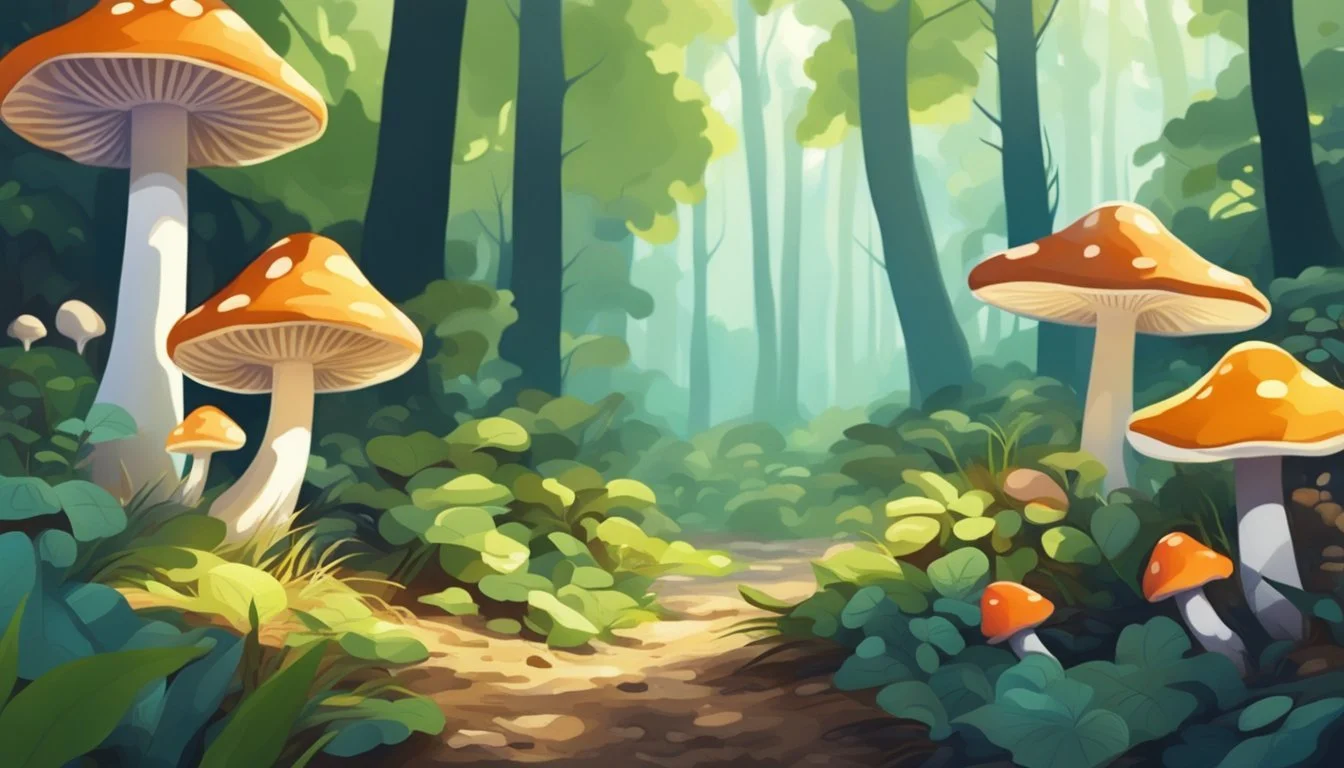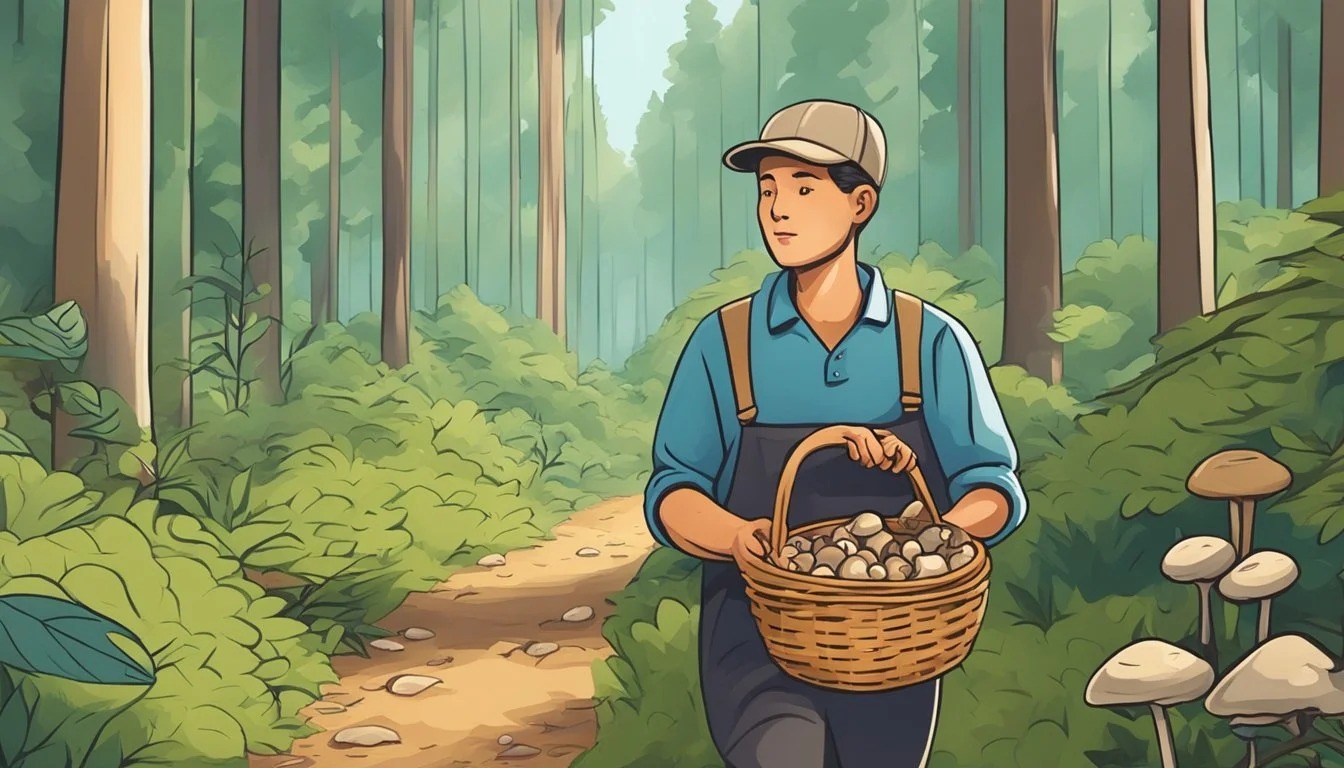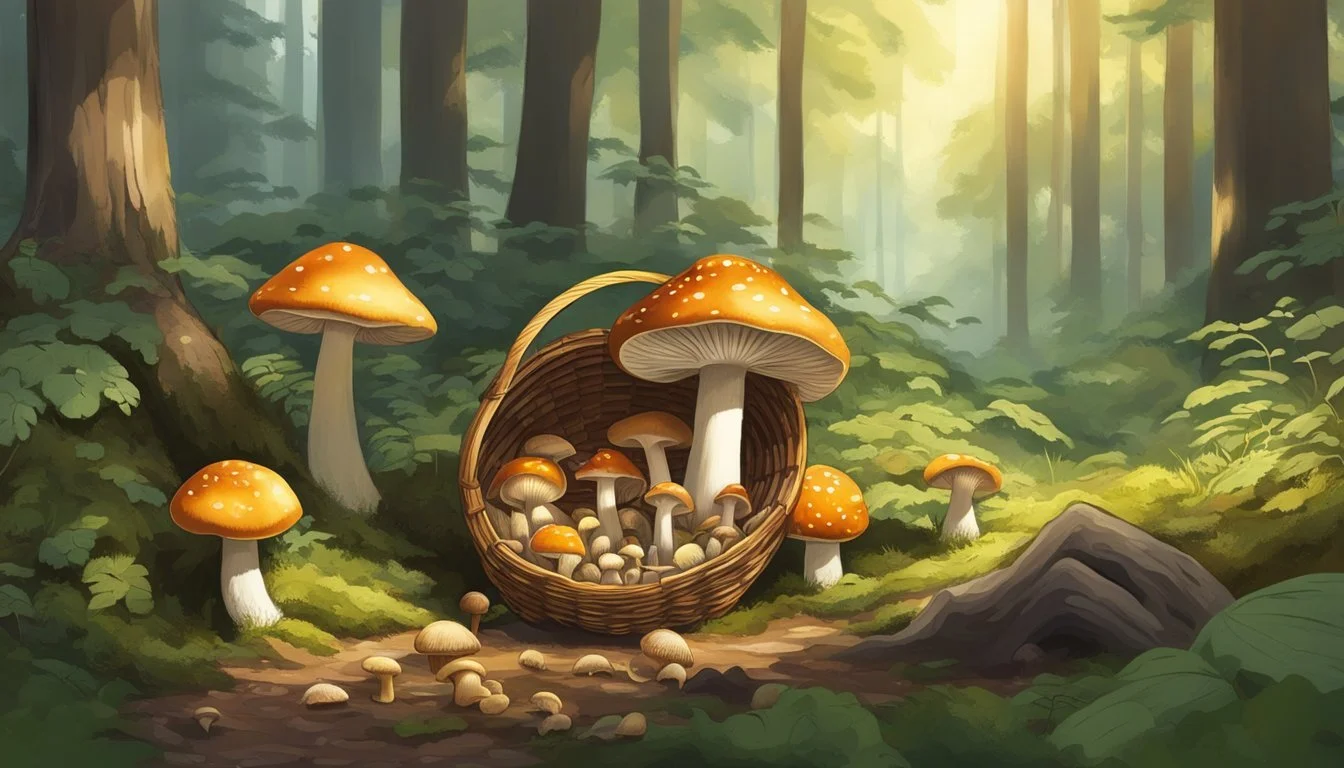Mushroom Hunting Georgia
A Guide to Safe Foraging Practices
This Article is Part of Our Guide on Mushroom Hunting for All 50 States
Mushroom hunting in Georgia offers a diverse and rewarding experience for foragers of all levels due to the state's rich variety of ecosystems and tree species that support fungal growth. As mushrooms often appear after rainfall and are influenced by specific weather conditions, Georgia's climate provides fertile ground for a range of mushroom species. From the sought-after golden chanterelles that emerge in the spring to early summer months to the turkey tail mushroom which grows from late May to December, the state's forests are a forager's haven.
Safety is paramount when mushroom hunting, as the state is home to both edible and highly poisonous fungi. Knowledge of local species, proper identification techniques, and foraging best practices are essential to ensure a safe and enjoyable mushroom hunting experience. Georgia's natural diversity includes a vast array of mushrooms that vary with the seasons and are spread across different regions, each with its own unique foraging opportunities.
Aspiring mycologists and seasoned foragers alike can find value in understanding the ecological relationships between mushrooms and their habitats in Georgia. Certain mushrooms are more likely to be found in woods rich with specific tree types, and identifying these trees can be as much as a skill as identifying the fungi themselves. The art of mushroom hunting in Georgia is as much about the joy of the search as it is about the bounty it may yield.
Foraging for More Than Just Mushrooms in Georgia
Georgia's diverse landscapes, from the Appalachian Mountains to the Coastal Plain, offer a wealth of wild edibles for the curious forager. While mushrooms are a popular find, the Peach State's rich ecosystems provide a bounty of berries, nuts, greens, and roots. Discover the joys of foraging and immerse yourself in nature's abundance in Georgia's picturesque wilderness, from the lush forests of the Chattahoochee-Oconee National Forest to the sprawling marshes of the Okefenokee Swamp.
👉 Foraging for Wild Edibles in Georgia
Commonly Found Edible Mushrooms in Georgia
Georgia is home to several edible mushroom species. Some of the most commonly found edible mushrooms in the state include:
Chanterelle (Cantharellus spp): Highly prized for its fruity aroma and peppery flavor, this golden mushroom is a favorite among foragers and chefs in Georgia.
Black trumpet (Craterellus cornucopioides): Also known as the horn of plenty, this mushroom has a delicate, smoky flavor and is often used in gourmet cuisine.
Indigo milk cap (Lactarius indigo): With its vibrant blue color when young, this mushroom exudes a blue milk when cut and has a mild, nutty flavor.
Porcini (Boletus edulis): Commonly found in Georgia's forests, the porcini mushroom has a meaty texture and a rich, nutty flavor, making it a sought-after ingredient in many dishes.
Morels (Morchella spp): Highly sought after, morels are distinct with their honeycombed caps.
Honey Mushroom (Armillaria Tabescens): A golden-capped variety that tends to grow in clusters.
Wood Ear (Auricularia auricula-judae): Often found on trees, these mushrooms are ear-shaped with a jelly-like consistency.
Common Puffball (Lycoperdon perlatum): Globular fungi that are white to brown and can be found in grasslands and woods.
Pecan Truffle (Tuber lyonii): Typically found underground near pecan trees, truffles (What wine goes well with truffles?) are a culinary delicacy.
Turkey Tail (Trametes versicolor): Known for their striking colors and fan-like shape, turkey tails are not typically consumed but used in teas for their medicinal properties.
Boletes (Boletus spp): These are identifiable by their stout stems and sponge-like undercaps.
Chicken of the Woods (Laetiporus sulphureus): This brightly colored, shelf-like mushroom grows on dead or dying hardwood trees, particularly oaks, from spring through fall.
It is essential to properly identify any mushroom before consuming it, as some species can be poisonous. Beginners should go mushroom hunting with an experienced guide or join a local mycological society to learn how to identify edible mushrooms safely.
Basics of Mushroom Hunting
Mushroom hunting in Georgia offers an opportunity to blend an outdoor adventure with the quest for gastronomic delights. One must understand the practice, respect ethical considerations, and carry the right equipment.
Understanding Mushroom Hunting
Mushroom hunting, or foraging, is the practice of identifying and collecting edible mushrooms in their natural environments. It requires a thorough knowledge of local mushroom species, as some are edible while others can be toxic. Seasonality plays a crucial role, as different mushrooms flourish at specific times of the year. It is advisable for beginners to hunt with seasoned foragers or consult reliable guides to avoid misidentification.
Mushroom Hunting Ethics
Ethical mushroom hunting ensures sustainability and minimal impact on ecosystems. Foragers should:
Only harvest mushrooms they can positively identify as safe.
Leave behind young, immature specimens to allow for spore dispersion and population growth.
Respect private property by foraging only in permissible areas.
Avoid overharvesting to preserve species for wildlife and other foragers.
Equipment Essentials
For a successful foray, hunters should be equipped with specific items:
Foraging Bag: A mesh bag allows for spores to disperse as one carries their finds, promoting growth of new mushrooms.
Basket: An alternative to bags, a basket can carry mushrooms without crushing delicate specimens.
Foraging Tools: A knife is essential for cleanly cutting mushrooms, while a brush is useful for dirt removal.
Navigation Aids: GPS or reliable maps are crucial for safe navigation in woodlands.
These essentials, paired with knowledge and respect for nature, pave the way for a rewarding mushroom hunting experience.
Safety and Regulations
Mushroom hunting in Georgia requires knowledge of mushroom species to prevent the gathering of poisonous varieties and adherence to state regulations to ensure legal foraging.
Identifying Edible versus Poisonous Mushrooms
When foraging for mushrooms, one must be able to differentiate between edible and poisonous species. Mushrooms such as the Ringless Honey Mushroom are considered safe and can be identified by their honey (how long does honey last?)-colored cap and white spores. However, some mushrooms closely resemble edible ones but are highly toxic. It is imperative for foragers to have thorough knowledge or consult expert resources because consuming poisonous mushrooms can lead to severe health risks or even death. To help with identification, foragers can use:
Field guides specific to Georgia mushrooms
Workshops or foraging tours with mycology experts
Online resources from reputable organizations
Georgia Mushroom Regulations
In Georgia, mushroom hunters must comply with state regulations. These regulations include:
Possession of a valid hunting license for collecting mushrooms on public lands
Adherence to bag limits and hunting seasons specified in Georgia's hunting regulations
Awareness of rules governing the sale of wild-harvested mushrooms, as they are regulated due to the potential health risks posed by misidentified species
For detailed regulations and legal guidelines, foragers should refer to documentation from the Georgia Department of Agriculture and the Department of Natural Resources Division.
Mushroom Species in Georgia
Georgia's diverse terrain provides an excellent environment for a variety of mushrooms, ranging from the subtropical regions to the mountainous landscapes, where numerous edible species thrive.
Mushroom Identification Techniques
Proper identification is crucial when foraging mushrooms due to the presence of toxic species such as certain Amanita. There are several techniques one can use to differentiate between edible and poisonous varieties:
Visual inspection: Note characteristics like cap shape, color, size, gill structure, stem features, and any unique markings.
Spore print: Collecting the spore print can help in distinguishing species as the color of the spores can be indicative of the type of mushroom.
Habitat checking: Since many mushrooms have particular environments they grow in, recognizing the habitat can aid in identification.
Before consuming any wild mushrooms, it is highly recommended to consult with local experts and use multiple field guides to ensure safe and accurate identification.
Seasonal Considerations
The pursuit of mushroom hunting in Georgia is heavily influenced by seasonal patterns, which dictate not only the variety of fungi available but also their abundance. Key factors such as temperature, rainfall, and specific growth conditions are essential for hunters to consider.
Best Time to Hunt Mushrooms
In Georgia, the best time to hunt mushrooms typically aligns with the spring and fall seasons. The specific timing may vary depending on weather conditions each year, but hunters can generally find a diverse range of fungi during these periods. Late March often marks the onset of favorable conditions for mushroom emergence.
Spring Mushroom Hunting
Spring offers a prime opportunity for mushroom enthusiasts, as it presents the first wave of fungal growth after winter's thaw. The period starting from late March is notable for the appearance of morels - a sought-after variety among foragers. They should pay attention to warm, moist soil conditions, which are indicative of mushroom proliferation.
Fall Mushroom Foraging
Fall is characterized by another peak in mushroom activity within Georgia's forests. This season is less predictable but can yield a bountiful harvest for those who monitor the aftermath of rainy days and significant drops in temperature. Cool nights and warm days create an ideal environment for a range of mushrooms to flourish before winter sets in.
Habitats and Locations
In Georgia, mushroom enthusiasts find a diverse array of fungi across various habitats, each characterized by distinct forests and trees, soil types, and identifiable mushroom hotspots.
Forests and Trees
The forests of Georgia showcase a range of host trees that are conducive to mushroom growth. Oak trees are particularly known for supporting species like the Ringless Honey Mushroom, which flourishes on stumps and trunks in local parks. The Blue Ridge Mountains provide an environment rich with fir and spruce trees, where mushrooms that favor coniferous partners can be found. Forest floors, often covered in moss, create moist conditions ideal for fungal proliferation.
Notable Trees for Mushroom Hunters:
Oak Trees
Fir Trees
Spruce Trees
Host Trees in the Blue Ridge Mountains
Soil Types and Conditions
Mushrooms thrive in a variety of soil conditions throughout Georgia. The state's soils are predominantly acidic, but neutral to alkaline soils can be found in certain areas. As soil type directly influences mushroom presence, a soil map can be an indispensable tool for hunters. Specific soil types, like those found in mossy areas or near decomposing wood trunks, provide the nutrients required by fungi with gills or pores for their development.
Key Soil Conditions:
Acidic Soil (most areas)
Neutral to Alkaline Soil (less common)
Finding Mushroom Hotspots
The best mushroom spots in Georgia are typically determined by the interplay between topography, altitude, and the associated vegetation. Areas with dead or decaying wood, such as trunks and stumps, are excellent for locating species like Honey mushrooms. Altitude can be influential, as certain fungi prefer the higher, cooler, and damper conditions of mountainous regions. Knowledge of the local topography and the resulting microclimates can lead mushroom hunters to success.
Criteria for Hotspots:
Presence of dead or decaying wood
Higher altitude areas in mountainous regions
Practical Mushroom Foraging Tips
Mushroom foraging in Georgia requires skill and know-how, with safety and correct identification being of utmost importance. Utilizing reliable mushroom maps and understanding the proper harvesting technique can lead to a fruitful and enjoyable experience.
How to Harvest Mushrooms
When harvesting mushrooms, one should focus on the distinctive parts of the mushroom: the cap, stalk, and the color of the spore print. The cap should be intact, and a gentle twist is the recommended technique to remove the mushroom from the soil, ensuring the stalk is not crushed, which could make identification difficult. It is advisable to carry a basket or a paper bag, which aids spore dispersal for future growth. Here’s a brief guide:
Examine the cap: Check for color, size, and shape.
Observe the stalk: Look for specific features like thickness and presence or absence of a ring.
Take a spore print: Place the cap on paper and wait for spores to release to verify color.
Use appropriate tools: A knife can help cut the mushroom without disturbing the mycelium.
Mushroom Maps and Guides
For those hunting for mushrooms in Georgia, utilizing mushroom maps is crucial. They typically indicate fruitful regions while warning against areas that are known to be polluted or protected. It is important to consult updated guides specific to the state of Georgia, as mushroom species and their locations can vary annually.
MushroomStalkers and local foraging groups often provide updated maps.
Books or digital guides: "A Field Guide to the Mushrooms of Georgia" could serve as a comprehensive resource.
Mushroom foragers in Georgia should invest in a good field guide and make use of online mushroom maps, keeping an eye out for local species such as the Oyster mushroom and Ringless Honey Mushroom, among others. Proper education on mushroom varieties and growth conditions will enhance the foraging experience, helping to avoid species that look similar to edible varieties yet are toxic.
Preservation and Usage
When one has successfully foraged mushrooms, the longevity and safety of these edible treasures are paramount. Preservation and usage are critical components, ensuring wild mushrooms offer the best taste and nutritional benefits while minimizing the risk of spoilage.
Storing Gathered Mushrooms
Proper storage is crucial for maintaining the freshness and edibility of wild mushrooms. One should store fresh mushrooms in a cool, well-ventilated environment, ideally in a paper bag in the refrigerator. This method helps to regulate moisture, which is vital as excess moisture can lead to decay. For long-term storage, wild mushrooms can be dried, frozen, or pickled.
The table below summarizes the storage methods:
Method Description Storage Life Refrigerated In a paper bag for breathability. Several days to a week. Dried Slice and air-dry or use a dehydrator. Up to a year. Frozen Cooked or blanched then frozen. Several months. Pickled In a vinegar solution, stored in airtight jars. Up to several months.
Cooking with Wild Mushrooms
One must handle edible wild mushrooms with care during preparation. It's best to clean mushrooms with a brush or a damp cloth instead of rinsing them, as they can easily absorb water. Over medium heat, sautéeing wild mushrooms with simple ingredients like garlic, onions, and herbs accentuates their natural flavors. Cooking not only renders the mushrooms safe to eat by killing potential pathogens but also unlocks their full aromatic profile.
For the best culinary experience, the species of mushrooms must be considered, as each has its unique taste and texture. For instance, the Ringless Honey Mushroom can be excellent in stews, while the Golden Chanterelle is known for its delicate flavor, suitable for light sautées or creamy sauces.
Advanced Topics in Mycology
The pursuit of mycology in Georgia encompasses not only the identification and collection of various mushroom species but also plays a significant role in contributing to broader scientific knowledge. Collaborations with local mycologists and the scientific community are paramount in advancing the study of fungi.
Working with Local Mycologists
Local mycologists are instrumental in the identification and ecological understanding of mushroom species found throughout Georgia. These experts can provide comprehensive insights into the local mycological diversity. It's essential for enthusiasts to work alongside these specialists to properly document and study various specimens. Here are some key activities:
Collecting accurate data on mushroom species and their habitats.
Participating in local mycology clubs and events for knowledge exchange.
Contribution to Scientific Knowledge
Each collected specimen has the potential to add valuable information to the scientific community. By cataloging new and existing species, mycologists can track changes in fungal distribution and diversity. This contributes to fields such as ecology, climate change research, and even pharmacology if novel compounds are discovered. Important contributions include:
Submitting findings to mycological databases and journals.
Collaborating on research studies that investigate the environmental roles and medicinal properties of fungi.
Conservation and Future of Mushroom Hunting
Mushroom hunting in Georgia is an activity that intertwines the enjoyment of the outdoors with the subtle art of foraging. As this pastime gains popularity, its impact on ecosystems and the importance of sustainable practices cannot be overstated.
Impact of Mushroom Hunting on Ecosystems
Mushrooms play a critical role in Georgia's subtropical ecosystems. They break down organic matter, recycle nutrients, and form symbiotic relationships with plants. Excessive harvesting can disrupt these functions, affecting not just the fungi but also the plants and animals that depend on them. Legal regulations are essential in maintaining the delicate balance within these habitats. Georgia’s authorities set specific conditions to manage mushroom populations effectively, ensuring both their conservation and availability for future generations.
Promoting Sustainable Mushroom Hunting
To safeguard the future of mushroom hunting, promoting sustainable practices is vital. Georgia's mushroom hunters are encouraged to follow best practices such as:
Harvesting selectively: Taking only mature specimens and leaving younger mushrooms to mature can help maintain a healthy population.
Respecting regulations: Adhering to laws and guidelines ensures that hunting activities support long-term conservation goals.
By understanding and adhering to these principles, mushroom hunters can help preserve the state's diverse mycological resources for the enjoyment and benefit of all.






